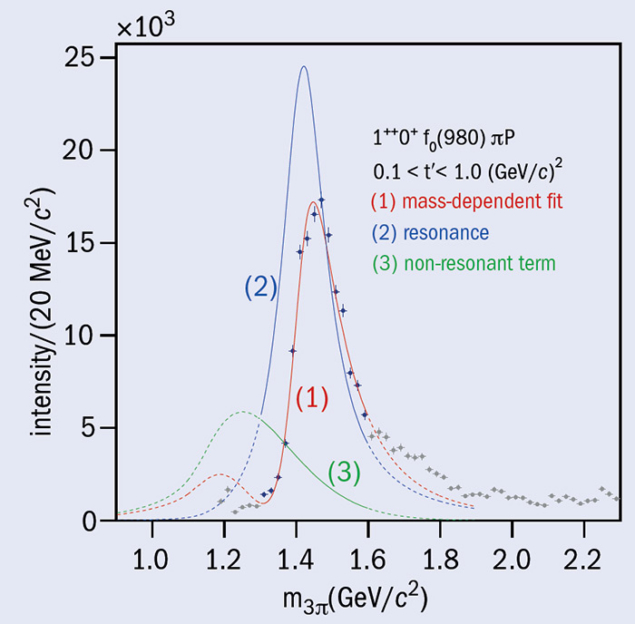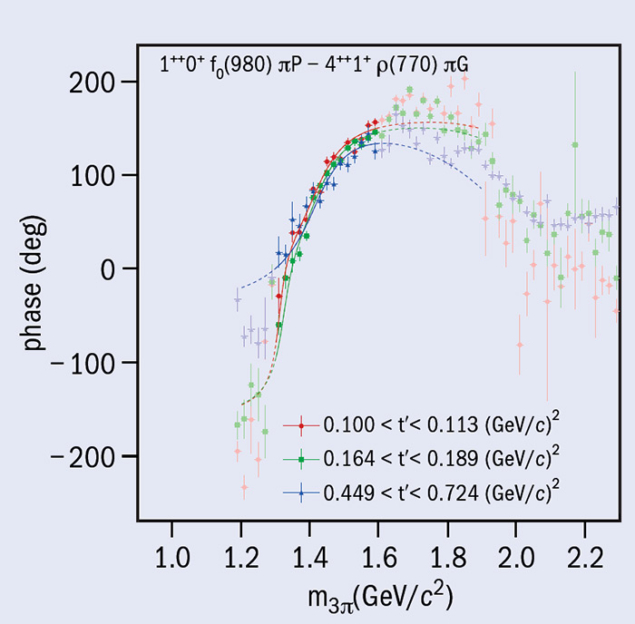
The bulk of visible matter originates from the strong interactions between almost massless fundamental building blocks: quarks and antiquarks bound together by gluons. Although these interactions are described by QCD, the understanding of the underlying principle – of how exactly these building blocks form observable matter (hadrons), and which configurations are or are not realized in nature – has been a major challenge for a long time. The question of how hadrons are formed relates directly to the excitation spectrum of hadrons, in particular, mesons, which are made from quark–antiquark pairs. Theoretical predictions on the nature of hadronic bound-states, their masses and decays, have long been based on models, but direct QCD calculations performed on high-performance computers using a discretized space–time lattice are now also reaching a predictive level for new hadron states.
The finding was made using the COMPASS spectrometer to study peripheral (diffractive) reactions of pions.
For many years, experiments have searched for hadronic bound states with exotic contents, such as gluon-only states (glueballs) or multi-quark states with a molecular nature. Some candidates had been found in studying systems with light quarks (glueballs, hybrids) or, most recently, with heavy quarks, revealing the first evidence for explicit multi-quark systems, based on the characteristic combination of charge and flavour.

The COMPASS collaboration has recently observed the existence of an unusual meson made from light quarks at a mass of 1.42 GeV/c2. Since this mass region had been investigated for half a century, this new particle comes as a surprise, and its finding is by virtue of the world’s largest data sample for such studies. The particle is called the a1(1420), reflecting its properties of unit spin/isospin and positive parity, characteristic of the “a” mesons. The finding was made using the COMPASS spectrometer to study peripheral (diffractive) reactions of pions with a momentum of 190 GeV/c on a liquid-hydrogen target at CERN’s Super Proton Synchrotron. Despite its production rate of only 10–3 with respect to known mesons, the existence of the a1(1420) was clearly unravelled using an advanced complex analysis technique that allows a produced superposition of individual quantum states to be disentangled into the individual contributing components, both in terms of quantum numbers and decay paths. The unique signature for this particular observation is a strong narrow enhancement in the mass spectrum of this JPC = 1++ quantum state (figure opposite) in conjunction with an observed phase delay of about 1800 – which any wave undergoes when its frequency (mass) passes a resonance.
The a1(1420) is observed decaying only into the f0(980), which is often discussed as a molecular-type state, and an additional pion, so rendering it unique. Following first announcements of the finding, several explanations have already been put forward. They cover the interpretation of the a1(1420) as a molecular/tetraquark state partnering another known state f1(1420), as well as scenarios in which the a1(1420) is generated by long-range effects of different sorts, all involving the light meson a1(1260). However, despite some remarkable features, not all of the experimental findings can be reproduced by those explanations. Thus, the a1(1420) enters the club of resonances that are unexplained, although experimentally well established.
Further reading
COMPASS Collab. 2015 arXiv:1501.05732





